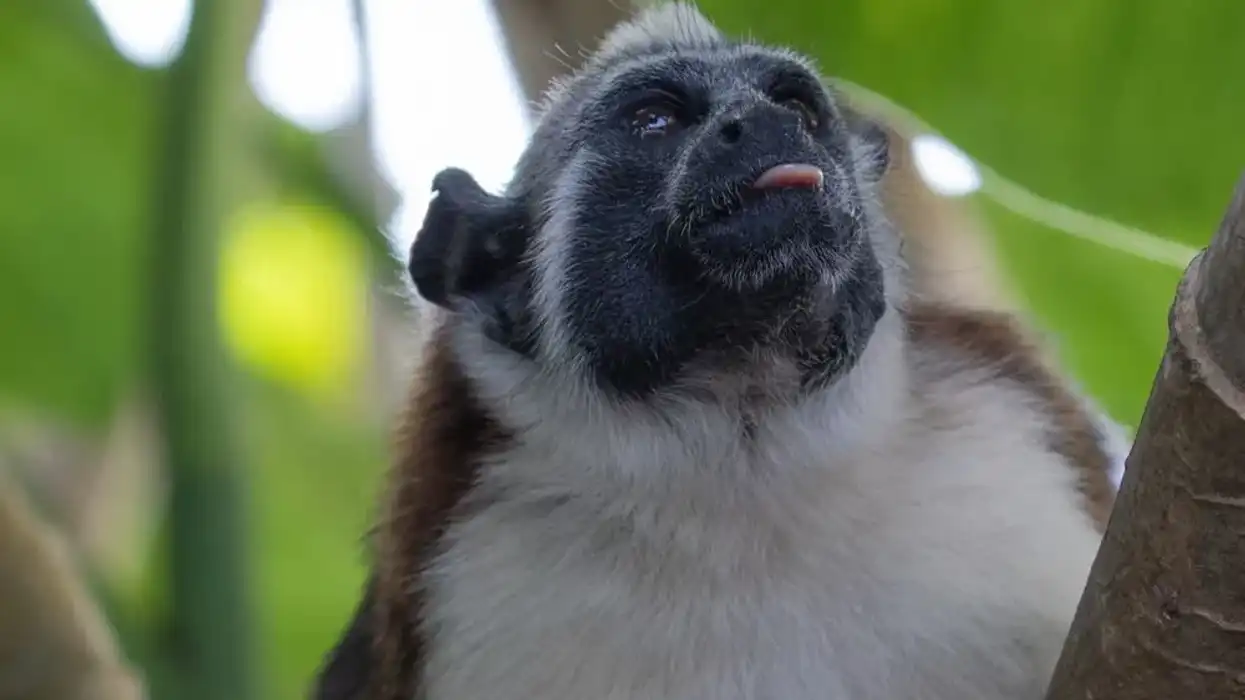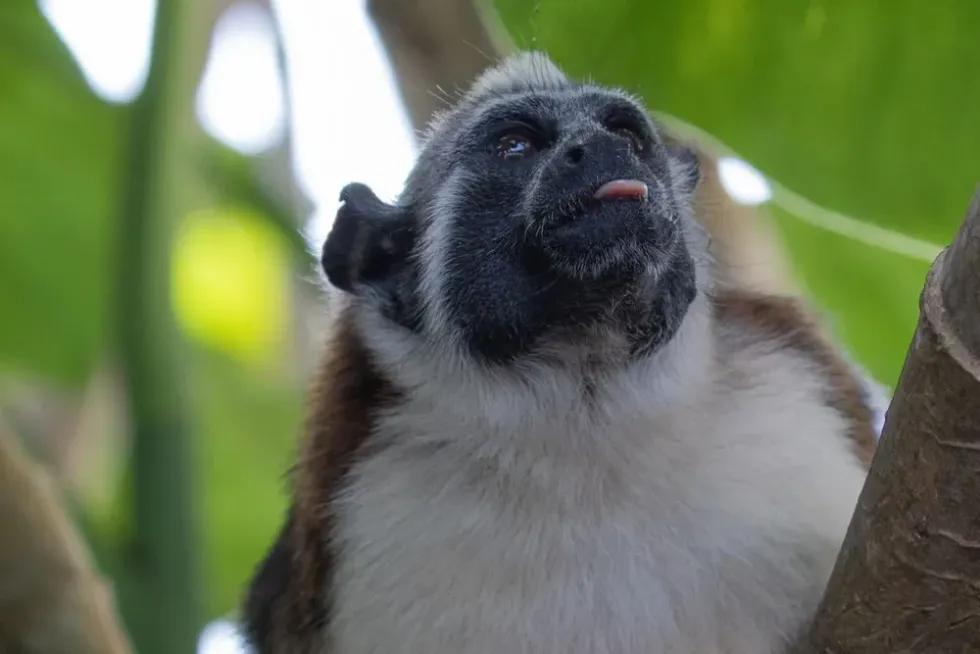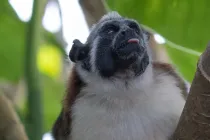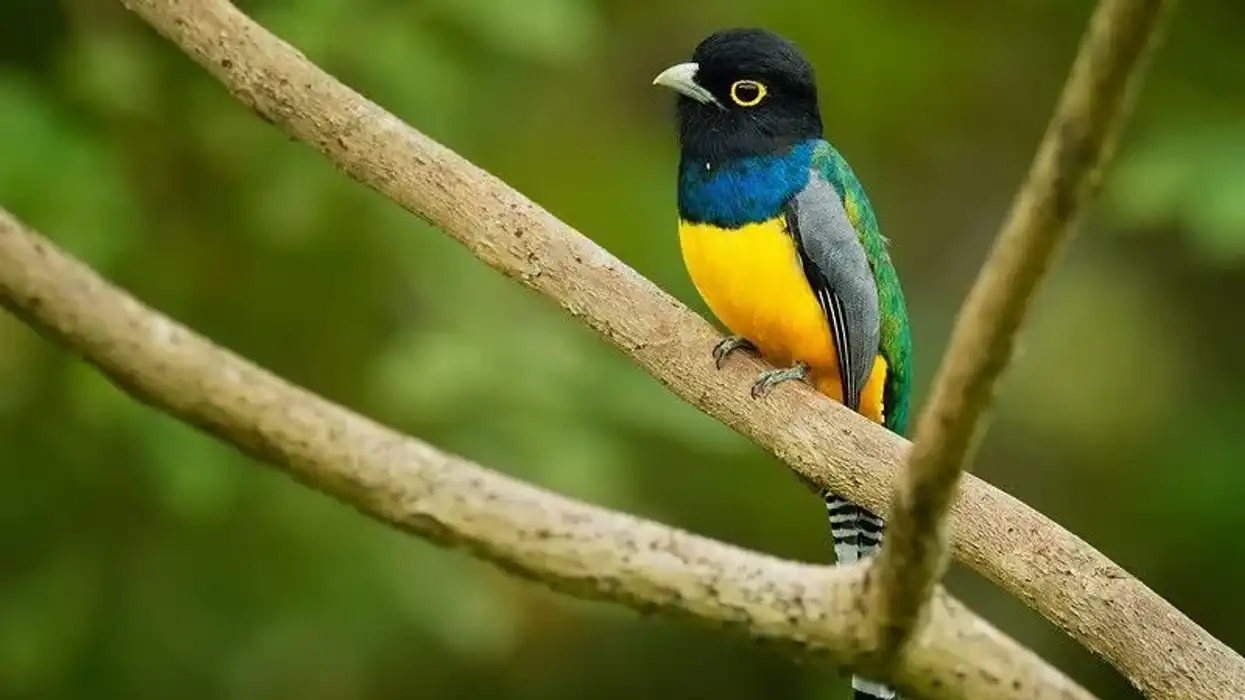Fun Geoffroy's Tamarin Facts For Kids

Content
- What type of animal is a Geoffroy's tamarin?
- What class of animal does a Geoffroy's tamarin belong to?
- How many Geoffroy's tamarins are there in the world?
- Where does a Geoffroy's tamarin live?
- What is a Geoffroy's tamarin's habitat?
- Who do Geoffroy's tamarins live with?
- How long does a Geoffroy's tamarin live?
- How do they reproduce?
- What is their conservation status?
- What do Geoffroy's tamarins look like?
- How cute are they?
- How do they communicate?
- How big is a Geoffroy's tamarin?
- How fast can a Geoffroy's tamarin run?
- How much does a Geoffroy's tamarin weigh?
- What are the male and female names of the species?
- What would you call a baby Geoffroy's tamarin?
- What do they eat?
- Are they friendly?
- Would they make a good pet?
- Did you know...
- How do Geoffroy's tamarins communicate?
- What are the similarities between Geoffroy's tamarins and tyrant flycatcher birds?
Geoffroy's tamarins are one of the tiniest monkey species in the entirety of Panama. These monkeys live in groups, and their diet is made of fruits, tree sap, flowers, and other small insects.
The number of individuals in their groups can vary anywhere between three to five. This monkey is primarily found in countries like Colombia and Panama, especially on the island of Barro Colorado.
Unlike other monkey species, Geoffroy's tamarins like to come down to the ground. However, this happens very rarely, and they only do so to collect food. The males of this monkey species are smaller in size than females. The males also spend more time caring for their young than females do.
This monkey is considered to be of Least Concern by the IUCN, but due to habitat loss their population is declining. In Panama, this monkey species is often hunted or captured for illegal pet trades. This monkey species can survive for a maximum of 13 years.
By the end of this article, you will have knowledge on Geoffroy's tamarin habitats, Geoffroy's tamarin infra-orders, Geoffroy's tamarin prehensile tails, Geoffroy's tamarins locomotion and Geoffroy's tamarins sizes.
If you enjoyed these facts, you may also check out the fact files on western lowland gorilla and howler monkey.
Geoffroy's Tamarin Interesting Facts
What type of animal is a Geoffroy's tamarin?
Saguinus geoffroyi, also known as rufous naped tamarin or red crested tamarin, are a type of small monkey. They are usually found in Colombia and Panama, where they live in groups.
What class of animal does a Geoffroy's tamarin belong to?
Geoffroy's tamarin belong to the class mammalia. They also belong to the order of primates.
How many Geoffroy's tamarins are there in the world?
The population of Panamanian tamarin on the island of Barro Colorado ranges from between three to five monkeys per square kilometer. But, in other areas, their population size can be between 20 to 30 monkeys per square kilometer.
However, the actual population size of the species is unknown, and the IUCN terms their conservation status as Least Concern. Despite this, their numbers are decreasing due to habitat loss. There has been a decline in their natural habitat resulting in less breeding and more predators.
This affects the number of Geoffroy's tamarins that exist. There are efforts underway to help this species by creating protected forest habitats.
Where does a Geoffroy's tamarin live?
Geoffroy's tamarins (Saguinus geoffroyi) can usually be found in the primary and secondary forests of South America and Central America. They prefer dry and moist tropical forests with moderate humidity in Panama and Colombia.
What is a Geoffroy's tamarin's habitat?
Geoffroy's tamarin (Saguinus geoffroyi) are a small monkey species native to Panama and Colombia. They prefer tropical forests with moderate humidity, and range from north-western Colombia, along the Pacific Coast and Rio San Juan, to the Atlantic Coast of Panama.
Their habitat varies between different types of forests which include primary, scrub, disturbed secondary forests, dry deciduous forests and moist tropical forests. They prefer forests with dense foliage rather than open grassy areas.
Geoffroy's tamarins mostly live in treetops only come down to the ground occasionally.
They are diurnal in nature, and their diet includes eating solid food which includes fruits, flowers, insects, and plants. They also search for holes in tree trunks left by other animals in order to give birth to their babies.
Who do Geoffroy's tamarins live with?
Geoffroy's tamarins live in social family groups that range between three to 20 individuals. There is always more than one adult of both sexes present in the group. The adult from each group migrates across different other groups. Each group has both males and females.
How long does a Geoffroy's tamarin live?
Saguinus geoffroyi, also known as rufous naped tamarins, are a small monkey species that can live up to 13 years in captivity. However, in the wild, they can live for eight to 15 years.
How do they reproduce?
Saguinus geoffroyi have a unique mating system known as polyandrous mating. It means that a female tamarin will mate with multiple male tamarins. January and February is the typical mating season, and they give birth in March to June.
The gestation period ranges from 140 to 145 days. The gestation period is small and the same as cotton-top tamarins. Once a tamarin is of two years of age, they are fit to mate.
They give birth to single infants or twins, but one of the twins often passes away within the first few months. Female tamarins search for nests created by other animals to give birth in and protect the infants from predators.
These nests are usually hollow trunks or tree holes used as shelter by other animals. Tamarins have the capacity to reproduce throughout the year but typically become more active from April to June.
Longer periods between births are observed after tamarins have twins, and this can range from 154 to 540 days. It is the male tamarins who take care of the infants.
What is their conservation status?
According to the IUCN red list, Geoffroy's tamarins (Saguinus geoffroyi) conservation status is Least Concern. This is an indication that Geoffroy's tamarins have a stable population. But, in reality, the population size is decreasins.
They are suffering due to habitat loss in Panama. They are hunted, captured, and traded as pets in Panama and Columbia. Another of the main reasons for their declining population is due to the increasing human interference with nature.
Clearing down forests for agriculture and human settlement in Panama is contributing more to the loss of their habitat. This results in decreasing population numbers.
As a result, the species could eventually become threatened, and measurements need to be taken to ensure their conservation. There are specific animal shelters and national zoos in Panama that are helping with this. They are working to improve the conservation status of this monkey species.
Geoffroy's Tamarin Fun Facts
What do Geoffroy's tamarins look like?
Saguinus geoffroyi, also called rufous naped tamarin, are small monkeys that are usually found in South and Central America. They are found in black, yellow, and white color with a reddish nape.
At the top of the monkeys head is a white triangular Mohawk. The fur is short and black in color. Their faces are black and chubby.
Long, wispy white strands of hair extend from beneath their faces. The eyes are brown in color, and their ears are tiny and scalloped which means they're perfect for listening to the sounds of the forest.
Their body is cloaked by a fur coat of yellow, brown and black and the fur on the underside of their chest is white.
The tail is of reddish color with a furry black tip. Infants are engulfed in black fur with a beige blazer and a white hairless face.
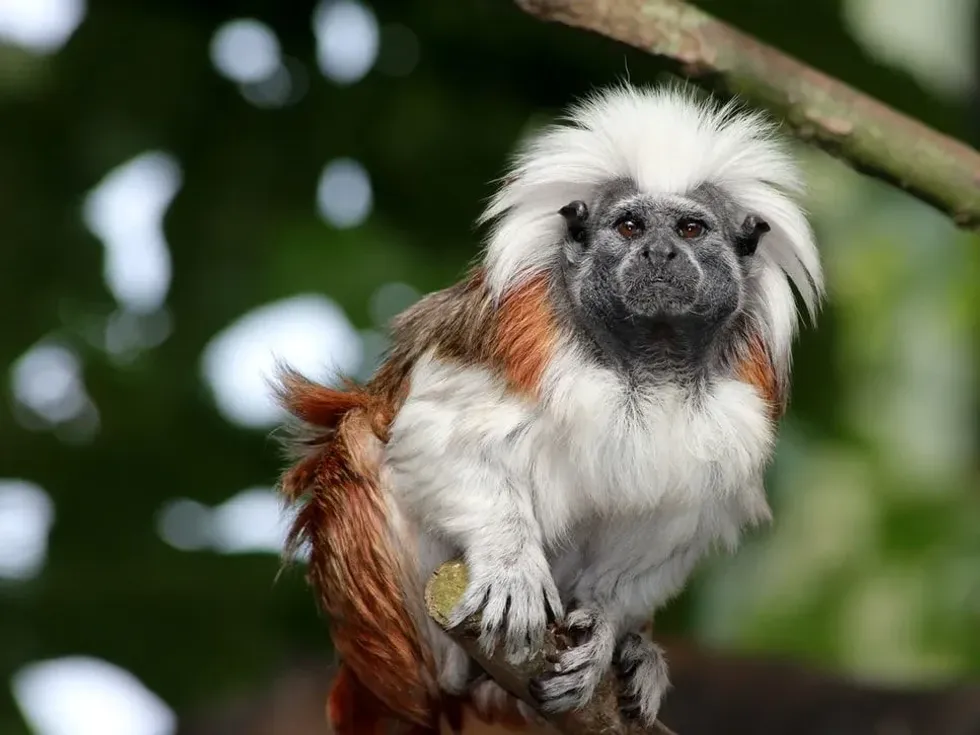
How cute are they?
Geoffroy's tamarins, or red crested tamarin, are very cute in appearance. They are native to Panama and are a type of small monkey.
The babies of this species are cute little monkeys with black fur and a chubby, white, hairless face. The infants cling on to their father tamarins backs for between six to eight weeks.
This is because the males handle infant care, which helps in bonding the family. Once they mature, they become a part of the family where a group size can range from three to 20 individuals.
How do they communicate?
Geoffroy's tamarins usually communicate through various gestures and vocalizations. Vocal tones include a variety of whistles and sharp notes ranging from long rasps, trills, twitters, and sneezes. Body gestures include displays of aggression by standing on their hind legs. They also vocalize certain tones to warn other animals of predators.
How big is a Geoffroy's tamarin?
The average length of these tamarins is 7-12 in (18-30 cm). The length of their tail, however, is around 12-16.5 in (31-42 cm). Female tamarins are 23 in (58 cm) in length. Males are slightly smaller and are 22 in (57 cm) in length. They are at least three times bigger than Madame Berthe's Mouse Lemur.
How fast can a Geoffroy's tamarin run?
Geoffroy's tamarins are quite fast and can run at a speed of 24 mph (39 kmph). This makes them at least two times faster than an adult squirrel.
How much does a Geoffroy's tamarin weigh?
Geoffroy's tamarins weigh around 0.4-2 lb (0.2-0.9 kg). Female tamarins are a bit larger and weigh around 1 lb (0.5 kg). Males weigh approximately 0.8 lb (0.4 kg). Tamarins are around five times heavier than pygmy marmosets.
What are the male and female names of the species?
There are no specific names for male and female tamarins. They are simply called male and female Geoffroy's tamarins.
What would you call a baby Geoffroy's tamarin?
Young Geoffroy's tamarins are called babies or infants.
What do they eat?
The diet of Geoffroy's tamarins (Saguinus geoffroyi) varies from meat to plants as they are omnivores. Their diet also includes nectar or tree sap and they look for areas of trees where they sap is already leaking.
Their diet includes solid food such as fruits, flowers, insects, lizards, and eggs. They remain at the top of trees most of the time and only occasionally come down to the ground in search of food.
They mainly look for food during the day time because they are diurnal. The majority of their diet consists of insects and fruits as they are easily available.
Are they friendly?
Geoffroy's tamarins are social animals, but they can occasionally becoming territorial within their groups. They have different body gestures to show aggression. They also vocalize and show different body gestures in order to warn other animals away from predators.
Aggression is mainly found during mating periods, especially when males compete to mate with a female tamarin. They hurt each other pretty badly and can cause deep lacerations, broken tails, and injured claws. Sometimes while fighting, tamarins may fall off the trees which can lead to their death.
Would they make a good pet?
Although Geoffroy's tamarins (Saguinus geoffroyi) are very cute monkeys, it is not recommended to have them as pets. Their numbers are already decreasing, and providing them a suitable habitat is not easy.
They tend to live at the top of a tree which is not possible for pet owners to provide. Thus, it is highly recommended to let them live in their natural habitats or protected areas. Tamarins are highly active animals, like other primates, and require much more dedication and care than a normal pet.
Did you know...
The scientific name of Geoffroy's tamarins is Saguinus geoffroyi. The name means 'of or pertaining to a marmoset'.
Though marmosets and tamarins belong to the same family, there are some differences between them. The teeth of marmosets are specially designed to dig into tree trunks and consume sap, but tamarins don't have specially designed teeth and they only consume sap from trees whose trunks are already leaking.
Tamarin Geoffroy's have a U-shaped jaw, whereas marmosets have a pointy face with a V-shaped jaw.
Tamarin monkeys are not endangered, but their population is decreasing. A number of factors contribute to the decrease in the number of tamarin Geoffroy's. Heavy deforestation for human settlement and agriculture is destroying their habitat.
Efforts are underway to provide them with more natural habitat so as to improve their status. All tamarins are small monkeys, and there are around 30 species of tamarins. A group of Geoffroy's tamarins is called a troop.
In spite of living at the top of trees, tamarins face many predators. Some predators can even climb trees and hunt this type of monkey.
The list of their predators include snakes, wild cats, hawks, and humans. It has also been observed that this species of monkey can become a nightmare for predators. They often form a crowd or mob and chase predators away from their territory.
Tamarins are like other primates. This means they are friendly, intelligent, and active with proper socialization. Still, it is not advised to keep them as pets because they need more dedication and care than a normal pet.
How do Geoffroy's tamarins communicate?
Geoffroy's tamarins communicate with a variety of body gestures and vocalizations. They show body gestures such as standing on their hind legs as a way to show aggression.
Female tamarins rapidly coil their tails to signal their male partners to start mating. Vocal tones include a variety of whistles, sharp notes, long rasps, trills, twitters, and sneezes. They also vocalize certain tones to warn other animals of predators.
What are the similarities between Geoffroy's tamarins and tyrant flycatcher birds?
Geoffroy's tamarins and tyrant flycatcher birds share some similarities among themselves, which includes diet and vocalizations. They both consume insects as their main diet.
Geoffroy's tamarins have the unique feature of listening to a tyrant flycatcher's calls and following it so that they can feast on the insects the bird finds. Saguinus geoffroyi are very opportunistic animals as they only consume insects, while the tyrant flycatcher does the hard work of finding them.
Here at Kidadl, we have carefully created lots of interesting family-friendly animal facts for everyone to discover! Learn more about some other mammals including red-handed tamarin, or Bornean orangutan.
You can even occupy yourself at home by drawing one of our Geoffroy's Tamarin coloring pages.
We Want Your Photos!
More for You
See All
Bachelor of Science specializing in Microbiology

Oluwatosin MichaelBachelor of Science specializing in Microbiology
With a Bachelor's in Microbiology from the Federal University of Agriculture, Abeokuta, Ogun State, Oluwatosin has honed his skills as an SEO content writer, editor, and growth manager. He has written articles, conducted extensive research, and optimized content for search engines. His expertise extends to leading link-building efforts and revising onboarding strategies.
Bachelor of Law

Abdulqudus MojeedBachelor of Law
A versatile professional with a passion for creative writing and technology. Abdulqudus is currently pursuing his Bachelor of Law from the University of Lagos and has experience as a tutor, intern assistant, and volunteer. He possesses strong organizational skills and is a detail-oriented person.
Disclaimer
1) Kidadl is independent and to make our service free to you the reader we are supported by advertising. We hope you love our recommendations for products and services! What we suggest is selected independently by the Kidadl team. If you purchase using the Buy Now button we may earn a small commission. This does not influence our choices. Prices are correct and items are available at the time the article was published but we cannot guarantee that on the time of reading. Please note that Kidadl is a participant in the Amazon Services LLC Associates Program, an affiliate advertising program designed to provide a means for sites to earn advertising fees by advertising and linking to Amazon. We also link to other websites, but are not responsible for their content.
2) At Kidadl, we strive to recommend the very best activities and events. We will always aim to give you accurate information at the date of publication - however, information does change, so it’s important you do your own research, double-check and make the decision that is right for your family. We recognise that not all activities and ideas are appropriate for all children and families or in all circumstances. Our recommended activities are based on age but these are a guide. We recommend that these ideas are used as inspiration, that ideas are undertaken with appropriate adult supervision, and that each adult uses their own discretion and knowledge of their children to consider the safety and suitability. Kidadl cannot accept liability for the execution of these ideas, and parental supervision is advised at all times, as safety is paramount. Anyone using the information provided by Kidadl does so at their own risk and we can not accept liability if things go wrong.
3) Because we are an educational resource, we have quotes and facts about a range of historical and modern figures. We do not endorse the actions of or rhetoric of all the people included in these collections, but we think they are important for growing minds to learn about under the guidance of parents or guardians.
